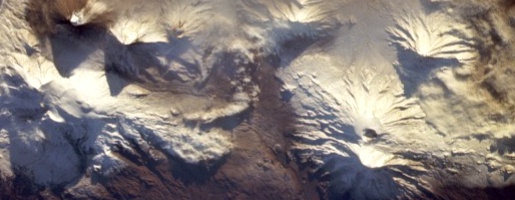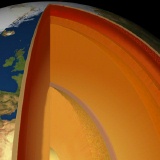 |
|||
|
Earth's
volcanoes are an outward sign of interior activity.
|
|||
| THE INTERIOR OF THE EARTH | |||
| The interior of the Earth is split into three zones of different composition: the outer crust, the interior mantle, and the central core. These zones differ in their chemical composition, but there are also physical variations, such as density and strength, between the zones and within the zones themselves. Temperature and pressure increase with depth, higher temperature tending to weaken the Earth's rocks, whilst higher pressure tends to strengthen them. | |||
 Cross-section through the Earth's interior. |
|||
| Crust | |||
| The Earth's crust consists of a thin layer of solid rock, typically 8 kilometres thick under the oceans, but averaging 45 kilometres beneath the continents. The crust is less dense than the rocks of the interior below. | |||
 Cross-section showing oceanic and continental crust. |
|||
| The crust is rich in the light elements oxygen and silicon, with significant amounts of the metal elements iron, aluminium, calcium, potassium and sodium. These elements are found in the form of solid chemical compounds - minerals. The most common minerals in the crust are the feldspars - silicates of calcium, sodium, potassium and aluminium. The oceanic crust is richer in basalt and denser than the continental crust. | |||
| Mantle | |||
| The mantle consists of solid rock, mainly magnesium and iron silicates - the olivine and pyroxene found in lavas at the surface. The upper mantle forms part of the lithosphere of cool, strong, rigid rock, which includes the crust. | |||
 Zones of different physical properties in the mantle. |
|||
| Temperature and pressure increase with depth, and a transition in the mantle's physical properties occurs at a temperature of 1,300oC and a depth of 100 to 200 kilometres. Below this transition, in the asthenosphere, rocks become weak and easily deformed (plastic). | |||
| The aesthenosphere reaches a depth of about 350 kilometres before increasing pressure causes an increase in rock strength. This region, extending down to the core-mantle boundary at about 2880 kilometres, is termed the mesosphere. | |||
| Core | |||
| The Earth's core is composed largely of metallic iron, with lesser amounts of nickel and other elements. In the outer core, temperature and pressure are so balanced that the iron is present in molten form as a liquid. Evidence for liquid iron in the core includes the presence of a strong magnetic field around the Earth. Pressure in the inner core (below about 5000 kilometres deep) is so great that the iron is solid. | |||
 The outer core is mobile liquid iron, where convection leads to the Earth's magnetic field. |
|||
|
|
|||